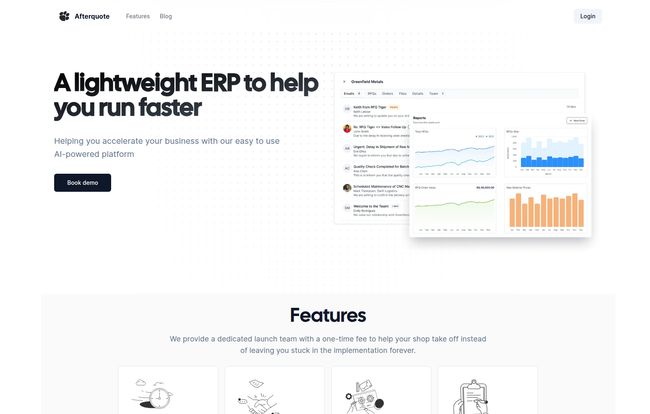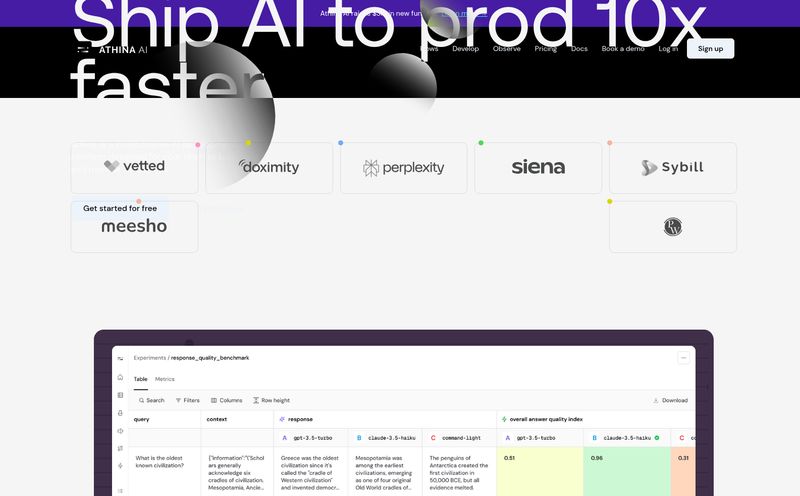If you run a manufacturing shop, you've probably got a love-hate relationship with spreadsheets. They're the duct tape of the business world—versatile, familiar, but you know deep down there has to be a better way. The quoting process alone can be a nightmare. You’re juggling RFQs from a dozen different emails, trying to track revisions in a spreadsheet that’s grown more complex than a Boeing wiring diagram, and praying you don’t miss a decimal point.
For years, the only alternative seemed to be these monstrous, wallet-destroying ERP systems. You know the ones. They promise to solve everything but require a team of consultants, a second mortgage, and a year-long implementation that disrupts your entire operation. It's like using a sledgehammer to crack a nut.
So when I stumbled upon Afterquote, my curiosity was piqued. It calls itself a "lightweight ERP," designed specifically to help businesses—especially manufacturers—run faster. An ERP that’s lightweight? And fast? Color me skeptical but intrigued. So, I decided to take a look and see if it's just more marketing fluff or a genuinely useful tool for shops tired of the chaos.
What Exactly is Afterquote? (And Who Is It Really For?)
First off, let's clear up what Afterquote isn't. It’s not trying to be SAP or Oracle. It’s not a sprawling, all-encompassing system that manages your HR, accounting, and the coffee machine schedule. And thank goodness for that.
Instead, Afterquote focuses on a very specific, very painful part of the manufacturing process: getting from a Request for Quotation (RFQ) to a paid order as smoothly as possible. It’s a dedicated tool for quote and order management. Think of it as a specialized command center for your sales and customer service process, built with the needs of a modern job shop in mind.
In my opinion, the ideal user for this is a small to medium-sized manufacturer who feels the growing pains. You're past the startup phase where a single spreadsheet worked fine, but you're not ready (or willing) to shell out six figures for a traditional ERP. You need visibility, speed, and a single source of truth for your orders. If that sounds familiar, keep reading.
The Core Features That Actually Matter
A platform is only as good as its features. Afterquote lists a few key ones, but I want to talk about what they mean in a practical, day-to-day sense for a busy shop.
AI-Powered Quoting: From Email to Quote in a Flash
This is the headline feature, the big promise. The platform claims to create quotes and orders directly from your emails with the help of AI. Now, the term "AI" gets thrown around a lot these days, sometimes to describe what is essentially a fancy template. The website is a bit light on the exact mechanics of how its AI does this, which is a bit of a pet peeve of mine.
But let's focus on the problem it's solving. The sheer time suck of manually re-entering data from an email into a quoting tool is a huge bottleneck. If Afterquote's AI can reliably parse an email, pull out the key details—customer name, part numbers, quantities—and pre-populate a quote, that’s a massive win. Even if it only gets you 80% of the way there, that's 80% less time spent on tedious data entry and more time on the important stuff, like ensuring the quote is accurate and profitable.

Visit Afterquote
A Sales Pipeline You Can Actually See
What happens after you send a quote? In many shops, it goes into a black hole. You might have a folder in your inbox for "Quotes Sent" or a line item on a spreadsheet, but there’s no real visibility. Which deals are hot? Which ones have gone cold? Who needs a follow-up?
Afterquote provides a clear, visual sales pipeline. You can track deals from the RFQ stage right through to a closed order. This isn't just about organization; it’s about business intelligence. Having this visibility lets you forecast revenue more accurately, manage your workload, and see where deals are getting stuck. It turns your sales process from reactive to proactive.
The Customer Portal: No More "Just Checking In" Emails
This might be my favorite feature. Every shop owner knows the constant trickle of emails and phone calls from customers asking, "What’s the status of my order?" It’s a necessary part of customer service, but it's also a constant interruption.
Afterquote gives your customers their own portal where they can log in and see the status of their orders in real-time. This is brilliant. It empowers your customers with the information they want, 24/7, without them having to bother you. It builds transparency and trust, and it frees up your team to focus on production rather than playing telephone. A real game-changer for customer experience.
Centralized File Storage (Yes, Even 3D Files)
"Can you resend the latest CAD file?" How many times have you heard that? Manufacturing involves a ton of files—drawings, 3D models (STEP, IGES), spec sheets, POs. Keeping track of the correct versions across different emails and network drives is a recipe for disaster. I’ve seen projects delayed because someone worked off an outdated drawing.
Having a single, centralized place to store and view all files associated with an order is critical. The fact that Afterquote specifically calls out support for 3D files shows they understand their audience. No more digging through emails to find that one specific .stp file the customer sent three weeks ago. It's all attached to the order. Simple, but so, so effective.
The Elephant in the Room: Implementation and Support
Here’s something that really caught my eye. On their homepage, Afterquote states, "We provide a dedicated launch team with a one-time fee to help your shop take off instead of leaving you stuck in the implementation forever."
This is a direct shot at the traditional ERP model, and it's a bold promise. The horror stories of ERP implementations gone wrong are legendary in the industry. The idea of having a dedicated team to get you up and running—for a one-time fee, no less—is incredibly appealing. It suggests they're invested in your success, not just in selling you a license and wishing you luck.
Let's Talk Money: Afterquote Pricing
Alright, so what does this all cost? The pricing page is refreshingly straightforward, up to a point.
| Plan | Cost | Key Features |
|---|---|---|
| Free | $0 | 50 RFQs, Up to 3 seats, 3 reports, File uploads, Audit log |
| Enterprise | Contact Us | Unlimited everything, Real-time collaboration, Premium Support |
The Free plan is actually... free. Not a 14-day trial, but a free-forever plan. And it’s not useless, either. 50 RFQs and 3 users is more than enough for a small shop to get started or for any size business to give the platform a thorough test drive. This is a huge plus in my book. It shows confidence in their product.
The Enterprise plan is where it gets a little hazy, with the dreaded "Contact Us" button. I get it; enterprise pricing is often tailored to specific needs, user counts, and support levels. But it’s always a bit of a letdown not to see at least a starting price. This is a common practice, but it does make it harder to budget and compare without getting on a sales call.
My Honest Take: The Good and The Not-So-Good
So, what’s the final verdict? I'm genuinely optimistic about Afterquote. It's not trying to reinvent the wheel; it’s just trying to build a much better, faster, and more user-friendly wheel for a very specific type of car.
The Good Stuff
I love the tight focus on quoting and order management. It solves a real, tangible problem without bogging you down with features you'll never use. The customer portal is a standout feature that can dramatically improve customer relationships and reduce admin overhead. And that generous free plan? It’s the perfect way to see if it fits your workflow without any risk.
Where It Could Improve
My main gripe is the lack of transparency. I'd love to see more detail on how the AI quoting actually works—is it machine learning, or just smart parsing? A case study would be fantastic. And of course, the opaque Enterprise pricing is a hurdle. Even a ballpark figure would be helpful for businesses trying to do their initial research.
Frequently Asked Questions About Afterquote
- Is Afterquote a full ERP system?
- No, and that's its strength. It’s a lightweight ERP that focuses specifically on RFQ, quote, and order management. It's designed to augment or replace that part of your workflow, not your entire business software stack.
- Who is the ideal user for Afterquote?
- Small to medium-sized manufacturers and job shops who are currently managing their quoting process with emails and spreadsheets and are looking for a more efficient, centralized system.
- Is there a free trial for Afterquote?
- Even better. There is a free-forever plan that allows for up to 50 RFQs and 3 users, making it perfect for small teams or for a comprehensive evaluation before committing.
- How does the AI quoting feature work?
- The platform states it uses AI to help create quotes and orders directly from your emails. The exact technical details aren't public, but the goal is to reduce manual data entry by automatically populating quote fields. A demo would be the best way to see it in action.
- What kind of files can I store in Afterquote?
- You can store various project-related files. Importantly for manufacturers, it supports standard documents as well as 3D files (like CAD models), ensuring all critical information is tied directly to the relevant order.
Is It Time to Ditch Your Spreadsheets?
Look, no software is a silver bullet. But from what I've seen, Afterquote is a seriously compelling option for manufacturers drowning in administrative chaos. It’s focused, modern, and seems to genuinely understand the pain points of its target audience.
If you're tired of chasing emails, wrestling with spreadsheets, and telling customers you'll "get back to them" on their order status, then Afterquote is absolutely worth a look. The free plan removes any barrier to entry. Give it a shot. What have you got to lose, except maybe that migraine-inducing spreadsheet you have open right now?



